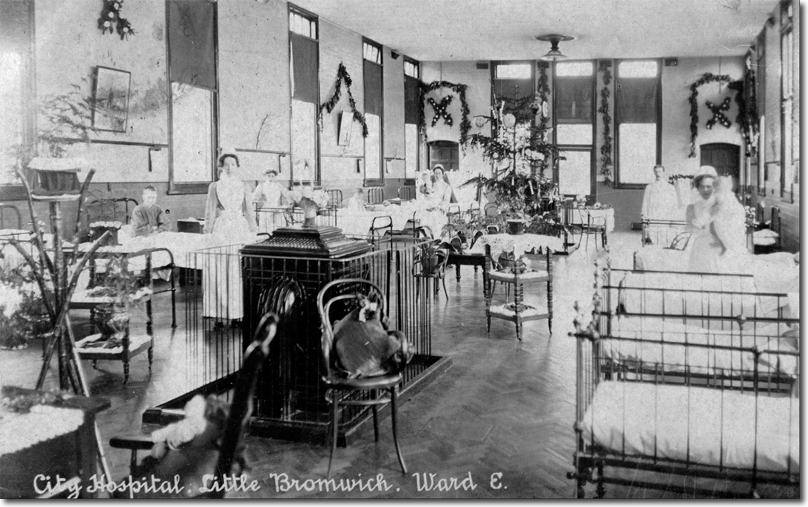|
|

 |
|
The first patients were admitted to the hospital on 29th June 1895. The hospital was built on a 23 acre site at Yardley, purchased by Birmingham Corporation for a cost of £4,975. The original plans drawn up by W.H.Ward included 10 pavilions of 24 beds each but only 4 pavilions were built when the hospital opened. It was known as City Hospital, Little Bromwich, as all hospitals run by the City Corporation were prefixed City Hospital- followed the location, this was dropped with the inception of the NHS in 1948. The hospital was not intended to be constantly occupied, but to be used at times of any smallpox epidemic outbreak; this was later extended to include cases of measles, scarlet fever, whooping cough, diphtheria and tuberculosis. In 1901, the hospital was used during an outbreak of typhoid, cause by the consumption of mussels harvested from river estuaries contaminated with sewage.
In 1904 the hospital at Little Bromwich was extended at a cost of £19,765 with the building of 3 further pavilions, an isolation ward and a home for fifty nurses, and again in 1910 further building increased it to 10 ward units with a capacity of about 300 beds. During the Great War the hospital was used for the treatment of soldiers with scarlet fever, measles, diphtheria and tuberculosis, and during 1916 there was a further outbreak of scarlet fever with 1232 cases admitted to the hospital. During the 1930’s the hospital expanded dramatically with the building of another fourteen wards increasing capacity to 750 beds. During the 1940’s and early 50’s due to better health care and living conditions the number of cases admitted declined, however in 1950 366 cases of polio were treated there, 46 of whom died. In 1948, when the NHS was formed Little Bromwich came under the control of Selly Oak Hospital Management Committee along with the Accident and Royal Orthopaedic Hospitals. With the decrease in infectious diseases, ward space at Little Bromwich became available and some services were moved from Selly Oak. In June 1951 a ward was opened for Ophthalmology, using a theatre already available. The same year wards began to be used as convalescent wards for patients recovering from medical and surgical treatment at Selly Oak Hospital. By 1953, 500 beds were available for general hospital use, and the hospital was “generalised”, in collaboration with Selly Oak. In September of that year a gynaecology department was established which remained there until 1971 when it moved to Marston Green. During the period 1959-61, over £380,000 was spent to improve facilities as a general hospital. In 1962, a new management committee was set up to manage Little Bromwich Hospital, together with Yardley Green, Hollymoor, Solihull, Witton and Marston Green Hospitals, and on the 1st April 1963, East Birmingham Hospital was created with the union of Little Bromwich and Yardley Green Hospitals, and by 1964 was dealing with over 10,000 patients per year. Image courtesy of Rob McRorie |
Armed Forces | Art and Culture | Articles | Biographies | Colonies | Discussion | Glossary | Home | Library | Links | Map Room | Sources and Media | Science and Technology | Search | Student Zone | Timelines | TV and Film